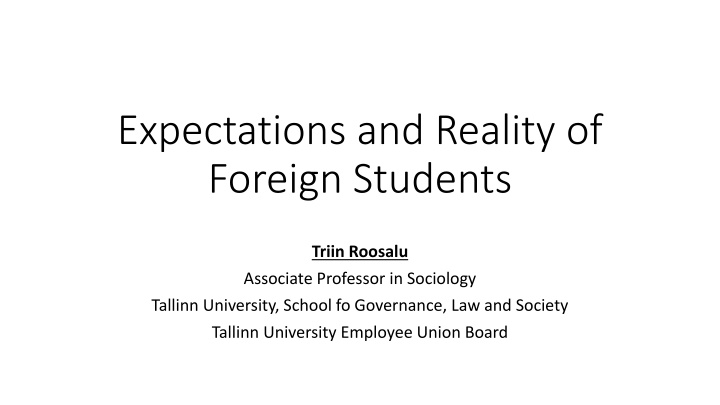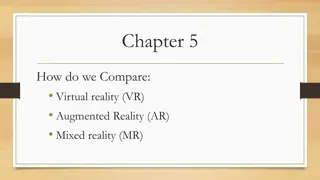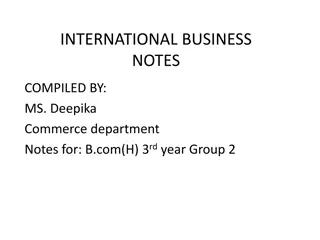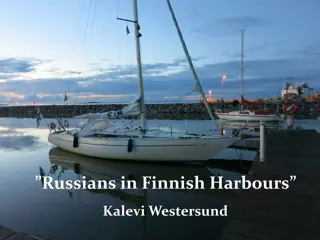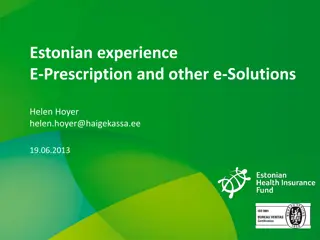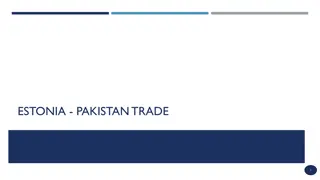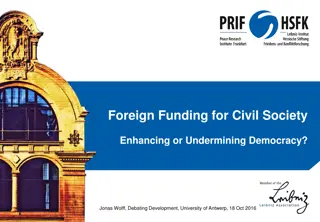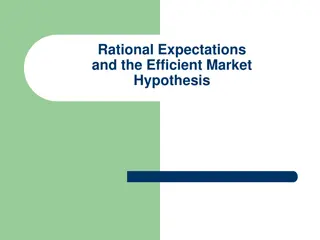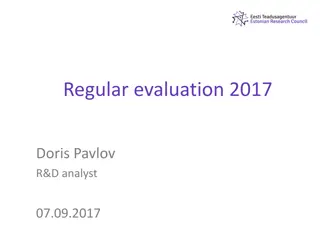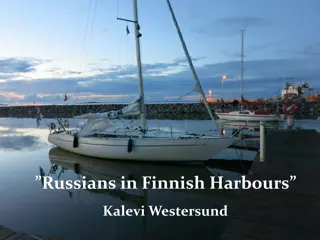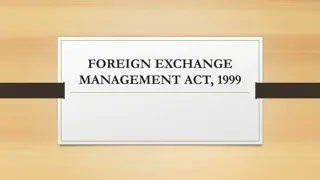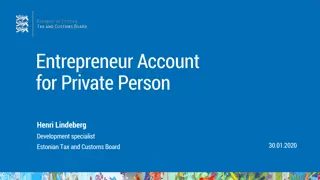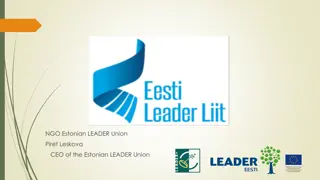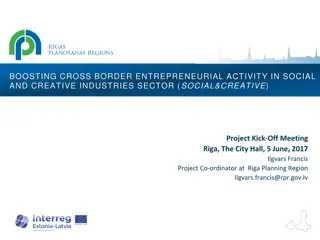Expectations and Reality of Foreign Students in Estonia
Associate Professor Triin Roosalu analyzes the structure of Estonian higher education, depicting the number of institutions and students over the years. The data shows the dynamics of publicly funded and fee-paying students, as well as the share of academic students. The statistics on foreign students, their educational levels, and countries of origin offer insights into the internationalization of higher education in Estonia.
Download Presentation

Please find below an Image/Link to download the presentation.
The content on the website is provided AS IS for your information and personal use only. It may not be sold, licensed, or shared on other websites without obtaining consent from the author.If you encounter any issues during the download, it is possible that the publisher has removed the file from their server.
You are allowed to download the files provided on this website for personal or commercial use, subject to the condition that they are used lawfully. All files are the property of their respective owners.
The content on the website is provided AS IS for your information and personal use only. It may not be sold, licensed, or shared on other websites without obtaining consent from the author.
E N D
Presentation Transcript
Expectations and Reality of Foreign Students Triin Roosalu Associate Professor in Sociology Tallinn University, School fo Governance, Law and Society Tallinn University Employee Union Board
Number of HEIs 1990-2013 50 45 40 35 30 25 49 49 47 47 46 41 20 39 37 35 35 35 34 34 33 33 32 15 29 27 26 21 10 20 5 6 0
Publicly funded or fee paying HE students and share of academic HE students 1997-2011 68767 68985 69 113 68 399 68 287 68 168 70 000 80% 67 760 65659 63625 60 409 70% 70% 60 000 68% 67% 56 437 66% 66% 66% 66% 64% 63% 63% 62% 60% 60% 60% 59% 50 000 49574 Akadeemilise suuna osakaal 50% 40 621 40 000 li pilaste arv 49% 34542 52% 40% 50% 53% 47% 52% 54% 54% 55% 54% 45% Students Academic HE 43% 30 000 35% 28% 30% 20 000 20% 10 000 10% 72% 65% 57% 55% 53% 50% 48% 47% 46% 45% 46% 46% 48% 51% 0 0% 97/98 98/99 99/00 00/01 01/02 02/03 03/04 04/05 05/06 06/07 07/08 08/09 09/10 10/11 Akadeemilise suuna osakaal Academic HE Riigieelarveline Public Riigieelarvev line Paying Source: T nisson, 2011.
Students by language of instruction 100% 90% 80% Russian 70% 60% English 50% Estonian 40% 30% 20% 10% 0% 8.11.2005 10.11.2006 10.11.2007 10.11.2008 10.11.2009 10.11.2010 10.11.2011 10.11.2012 10.11.2013
Number and share of foreign students in Estonia average share BA PhD MA Source: Estonian Ministry of Education Kreegipuu, 2017
Share of foreign students by educational level BA MA PhD Total Country Estonia Lithuania Latvia Finland Source: Estonian Ministry of Education Kreegipuu, 2017
Distribution of foreign students in Estonia by origin Number % Number % Number % Number % Number % Number % Finland Russia Nigeria Ukraine Georgia Estonia Turkey India Latvia China Total
Europe Europe Asia Asia Africa Africa Central Central- - and and Western Western America America Northern Northern America America Oceania Oceania
Foreign Students: 8+% of all; 11% of these in private universities English-language MA programs growing share among MA programs; yet only 66% of students there are foreign students some studies exist on students and on graduates Foreign Staff: less than 100 altogether in 2008/2009 about 100 in just one (smaller) university in 2017/2018 their prespective rarely covered with studies
Rationale, as stated in Ministry of Education report: Personal benefits for the students Academic skills and knowledge Social and sociocultural skills and knowledge employability domestic country vs host country vs other? Social, community level benefits Direct economic benefits Academic quality of education provision Keeping student numbers up employability and competition - - vs human rights ? cultural competence/intercultural competences/reciprocity?
Motives vs barriers Motives Intrinsic Instrumental Other? ARCS Attention Relevance Confidence Satisfaction Barriers Institutional Situational Dispositional
Integrating to labour market? In EU, countrywise, 16-30% of foreign students stay to integrate into labour market In Estonia, about 28% - beyond EU average
Any problems? Specific difficulties to find appropriate employment: Labour market entrance supported by local social networks foreigners lack these In many English-language curricula, apprenticehip is not compulsory and systematic support in contacting employers is often not provided Foreign students are not required to master Estonian language skills only specific jobs are available Not much provision in English available for professional education and as non- formal adult education only few opportunities for qualification beyond the university program
Feelings towards (country of) origin Feelings towards destination (country) Source: John Berry;
Expectations and Reality of Different Actors Students domestic and foreign Lecturers domestic and foreign Universities host and origin Countries host and origin layers of actors and each of their motives, barriers, and strategies
Motives vs barriers Motives Intrinsic Instrumental Other? ARCS Attention Relevance Confidence Satisfaction Barriers Institutional Situational Dispositional
Conclusions: to clarify Needs of and suggestions for universities Needs of and suggestions for teaching staff Needs of and suggestions for the sphere of education more generally, including adult education and lifelong learning Needs of and suggestions for the community Needs of and suggestions for the society Needs of and suggestions for the students Integration compass?
